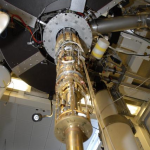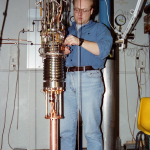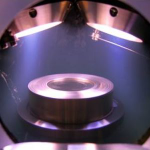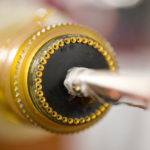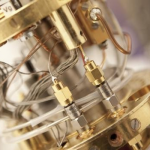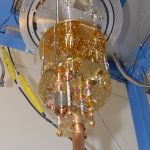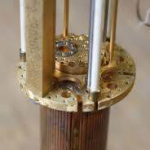

- Photon Transport in a Bose-Hubbard Chain of Superconducting Artificial Atoms
G. P. Fedorov et al., Phys. Rev. Lett. 126, 180503 (2021) - Path-Dependent Supercooling of the
He3 Superfluid A-B Transition
Dmytro Lotnyk et al., Phys. Rev. Lett. 126, 215301 (2021) - Superconductivity in an extreme strange metal
D. H. Nguyen et al., Nat Commun 12, 4341 (2021) - High-Q Silicon Nitride Drum Resonators Strongly Coupled to Gates
Xin Zhou et al., Nano Lett. 21, 5738-5744 (2021) - Measurement of the 229Th isomer energy with a magnetic micro-calorimeter
T. Sikorsky et al., Phys. Rev. Lett. 125 (2020) 142503
Mesoscopic quantum thermo-mechanics: A new frontier of experimental physics
E. CollinIn the last decade, experimentalists have demonstrated their impressive ability to control mechanical modes within mesoscopic objects down to the quantum level: it is now possible to create mechanical Fock states, to entangle mechanical modes from distinct objects, and to store quantum information or transfer it from one quantum bit to another, among the many possibilities found in today's literature. Indeed, mechanics is quantum, very much like spins or electromagnetic degrees of freedom; and all of this is, in particular, referred to as a new engineering resource for quantum technologies. However, there is also much more beyond this utilitarian aspect: invoking the original discussions of Braginsky and Caves, where a quantum oscillator is thought of as a quantum detector for a classical field, namely, a gravitational wave, which is also a unique sensing capability for quantum fields. The subject of study is then the baths to which the mechanical mode is coupled to, let them be known or unknown in nature. This Perspective is about this new potentiality that addresses stochastic thermodynamics, potentially down to its quantum version, the search for a fundamental underlying (random) field postulated in recent theories that can be affiliated to the class of the wave-function collapse models, and more generally open questions of condensed matter like the actual nature of the elusive (and ubiquitous) two-level systems present within all mechanical objects. However, such research turns out to be much more demanding than the use of a few quantum mechanical modes: all the known baths have to be identified, experiments have to be conducted in-equilibrium, and the word “mechanics” needs to be justified by a real ability to move substantially the center-of-mass when a proper drive tone is applied to the system.
AVS Quantum Sci. 4, 020501 (2022)
doi: 10.1116/5.0086059
arxiv: https://arxiv.org/abs/2204.09451

